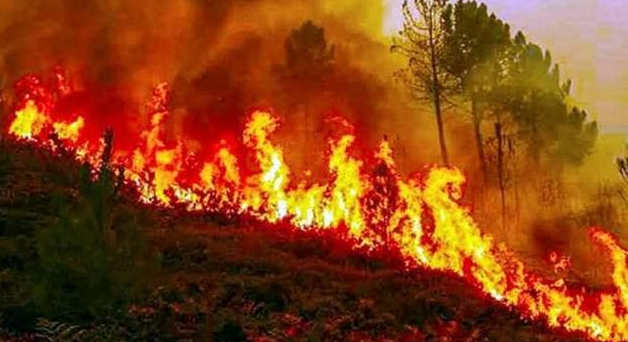Strategies to Combat Forest Fires in Himachal Pradesh (GS Paper 3, Environment)

Introduction
- Himachal Pradesh (H.P.) is grappling with an escalating challenge of forest fires, which pose significant threats to biodiversity, ecosystems, and local communities.
- Addressing this issue requires a comprehensive approach integrating proactive prevention, effective management, and community engagement.
Early Detection and Rapid Response Systems
Monitoring and Surveillance
- Technological Integration: Utilize satellite imagery, drones, and remote sensing technologies to monitor forest areas for signs of fire outbreaks.
- Fire Watch Towers: Establish and maintain a network of fire watch towers equipped with sensors and communication systems to enable early detection and rapid response.
Community Engagement
- Training Programs: Conduct regular training sessions for local communities on fire detection techniques, first response actions, and safety protocols.
- Community Reporting: Encourage communities to report suspicious activities or smoke sightings promptly to relevant authorities.
Improved Forest Management Practices
Fuel Management
- Controlled Burns: Implement controlled burning during cooler months to reduce the accumulation of dry vegetation and minimize the risk of large-scale wildfires.
- Vegetation Management: Conduct selective thinning of dense vegetation and underbrush to create firebreaks and reduce fuel load.
Restoration and Conservation
- Native Species Restoration: Prioritize the restoration of native tree species like Banj oak, which contribute to better moisture retention and ecosystem resilience.
- Sustainable Forestry Practices: Promote sustainable forestry practices that balance ecological conservation with community needs, reducing pressures that lead to fire risk.
Enhanced Firefighting Capabilities
Infrastructure Development
- Firefighting Equipment: Invest in modern fire suppression equipment, including fire trucks, hoses, and personal protective gear for firefighting personnel.
- Aerial Support: Utilize helicopters equipped with water buckets or fire retardants for rapid aerial firefighting operations in inaccessible terrain.
Community Participation and Empowerment
Integration of Traditional Knowledge
- Local Expertise: Incorporate traditional ecological knowledge of forest ecosystems and fire management practices into official strategies and decision-making processes.
- Community Fire Brigades: Establish and support community-based fire brigades trained to respond swiftly to small-scale fires before they escalate.
Policy and Legal Framework Strengthening
Forest Governance
- Legal Recognition: Ensure legal recognition and protection of traditional forest rights of local communities, enabling them to participate in sustainable forest management and fire prevention efforts.
- Regulatory Measures: Enforce strict regulations on activities such as land-use change, logging, and tourism to minimize environmental degradation and fire risk.
Awareness and Education
Public Outreach
- Education Campaigns: Launch extensive public awareness campaigns through media, schools, and community forums to educate residents about fire risks, prevention methods, and emergency procedures.
- School Curriculum: Integrate fire safety and environmental education into school curricula to cultivate a culture of responsible environmental stewardship from a young age.
Research and Innovation
Technological Advancements
- Research Initiatives: Support research and development of innovative technologies for early detection, fire behavior prediction, and improved firefighting techniques tailored to Himalayan forest ecosystems.
- Data Analytics: Use advanced data analytics and modeling to assess fire risk factors, prioritize high-risk areas, and optimize resource allocation for fire management.
Collaboration and Funding
Multi-Agency Coordination
- Partnership Building: Foster collaboration between government agencies, non-governmental organizations (NGOs), research institutions, and local communities to enhance coordinated efforts in fire prevention and management.
- Financial Support: Secure funding from national and international sources, including disaster management funds and environmental grants, to strengthen infrastructure, capacity-building initiatives, and sustainable forest management projects.
Conclusion
- By implementing these integrated strategies, Himachal Pradesh can significantly enhance its resilience against forest fires, protect its rich biodiversity, and safeguard the livelihoods of communities dependent on forest resources.
- Proactive measures, community involvement, and sustainable management practices are pivotal in mitigating the devastating impacts of forest fires and ensuring the long-term health and sustainability of its forest ecosystems.


